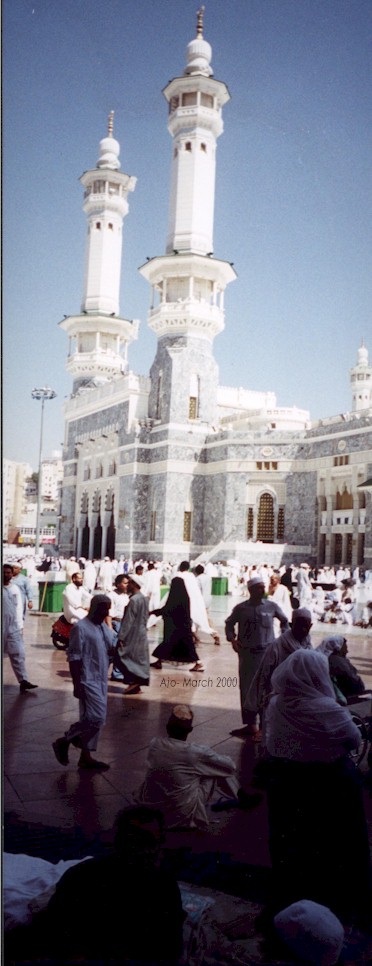 |
 |
Alhamdu-lilla, Allah has afforded me the
opportunity to perform Hajj, the fifth pillar of
Islam. I pray that Allah accept my Hajj and that of all the brothers
and sisters, and grant us Hajj Mabroor, InshahAllah, Ameen.
Before I left for my trip on March 8th 2000, I received
countless phone calls from family and friends expressing their well-
wishes. The calls from relatives of my age were mixed with surprise and
excitement, while those from my peers were more of pride and joy. I would
like to take this opportunity to thank all of you who called, wrote,
visited me and also those who took the time to come to the Airport,
Jazakum Allah Khair.
I answered the call of Allah, Subanahu Wataallah (SWT),
not without the usual uncertainty that one goes through when embarking on
a journey such as this. The constant second guessing of oneself, of my
preparedness, my current level of practice of Allah (SWT)commands and all
the past and present neglect that I have been so guilty of. These thoughts
created havoc in my mind. Nevertheless, I knew one thing for sure, if I
was going to make Hajj, then I had better be prepared. (top)
Preparation
I read all the books and articles on the
Internet, that I could find and went to a seminar, but most of all, I
spoke to people I knew who performed Hajj recently. In that regard, no
books, articles or
seminars was as helpful and informative to me as my long phone
conversations (some of which he initiated) with Uncle
Mansoor. He and Aunty Zai had made Hajj the previous year (1999) and
they were eager to answer much of the questions that I had regarding the rituals of Hajj.
They even prepared a day to day Itinerary for me and compiled a book of supplications for
each step of the pilgrimage.
May Almighty Allah (SWT) reward them
generously for their help and support, even their last wish for me was,
"Hajj Mabruke". A dua that I will come to understand only too well.A few
weeks prior to my trip, as suggested by one of the Internet articles, I
started an exercise regimen, as aggressive as any other Khan's exercise
regimen could be, ten to fifteen minutes on the treadmill.
I did not
go back to bed after Fajr salaat and I
tried to reduce my hours of sleep. Needless to say, as I got closer to the
date of departure, my treadmill experience was just a memory. I had
developed a slight cold and it was all the excuse I needed to stop the
exercise.
Also on recommendation from Uncle Mansoor and other articles
that I read, I made my Will and brought my family up to date with our
financial affairs. Then again on advice, I packed a substantial amount of
patience, which turned out to be the most useful asset throughout my
journey.(top) |
Departure
We left J.F.K International airport on Wednesday March 8th 2000
at about 7:50pm, our first stop, Amsterdam, Holland. I stowed my hand luggage,
(in it was my Ihram, a belt, sandals, reading material and some light snacks)
then put my seat back, stretched out and went to sleep .
When I woke up
it was daybreak. I saw brothers and sisters performing their salaat so I made wudu and prayed salatul
Fajr, while sitting, just facing forward, not bothering about the direction of
Qibla. That was new for me.
We arrived at Amsterdam after about 6 hrs of
flying, (2:30am Thursday, New York time, 8:30am local time), waited an hour or
so then flew for an additional eight hours to Amman, Jordan.
At the Airport,
we did not find a designated changing area, but managed to find a suitable place
to change into Ihram, we
then offered our two rakat prayer, in a designated prayer room, made our
intention for Hajj
Tamattu, recited Talbiyah, then waited
for our flight to Jeddah.
Our group leader handed out I.D cards which we pinned onto the top portion of our Ihram
(rida). These cards identified us by our group name, our nationality, and listed
a cell phone number to call in case we get lost, it was printed in
English.
After six hours of waiting (8:00pm local time) we boarded our
flight. Two hours later, 10:00pm Jordan time, 11:00pm Thursday Jeddah time, we
arrived at the Airport. We were now a full 8 hrs. ahead of New York, which would
have been 3:00pm Thursday.
We exited the aircraft onto the tarmac and
were taken by busses to the Hajj Terminal. The drive was about 15 minutes
and we recited collective Talbiyah on the way. We had about three hours
wait until we went through Immigration and Customs, then an
additional seven hours before we got our busses to go to Makkah. At one
point, I was afraid that we would miss Jummah salaat at the
Haram.
Before we departed we had the pleasure of listening to a
welcome address by Dr. Faiz Al-Abideen, a Guyanese medical doctor who
resides and practice in the Kingdom of Saudi Arabia. He had also now
become an adviser to some members of the Royal family.
|
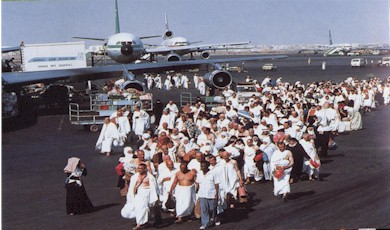 |
His work allowed him to visit the White House where he met
with President Bush who asked him, "Dr. Faiz, do you know that your religion is
one of the fastest growing religion in the United States today?". Dr. Faize
offered to take us to his home for breakfast but time did not permit.
We
stopped at various checkpoints along the way and passed by the ever famous
"Muslims Only" sign, on one of those stops we were each given a bottle of the
precious Zamzam water. As was expected the landscape was dry, mountainous and
had little greenery.
In Makkah our group leader surrendered our
passports at a "Holding Center" and we were given hand
bands and I.D. cards to carry with us at all times, this information was
written in Arabic.(top)
Makkah
By the time we got to our hotel it was very close to salatul
Jummah, we made wudu and rushed out to the Haram. There was
no way we could have made it into the mosque, because we were so late. The crowd
was already onto the streets so we had to settle for a space on the hot asphalt.
Alhamdu-lilla we had walked with our musallah (prayer mat). Later the next day
it was reported, in the Saudi Newspaper, that over 1.5 million people had
offered the Jummah prayer at the Haram.
 |
After salaat, we returned to the hotel. Just
before salatul Asr, I went back with another brother to perform Umrah. We
finished just before salatul Magrib, waited to pray Isha salat then
returned to the hotel. I showered and changed into street clothes then
went down to the hotel restaurant for dinner.
Our group was so
large that we had booked the entire hotel and taken over the kitchen.
Guyanese food was served.
Later that night I went back to Haram Shareef alone and
stayed until after Fajr salat. On my way to the mosque I observed the
layout of the streets. Numerous vendors lined the streets in store fronts
and on the sidewalk. These Store fronts, I had been told, was erected
specifically for commerce for the Pilgrims. There was a wide virety of
clothing but not so for food, (although personally, I found the
individually packed muffins and cakes to be quite a treat). Not far from
my hotel, there was a laundry, and further along the street were tea
vendors and soda vending machines.
I was prepared for the beggars, but
I was surprised to see them sitting in the middle of the sidewalk and
sometimes in the middle of the street when we would returned from salatul
Fajr. I had never seen so many deformed people in one place before in my
life. |
There was a Hospital at the corner of the street where
I entered the mosque and across from Gate number one (1) of the Haram, (King
Abdul Aziz gate), I could see KFC,
and Burger King. To my immediate right was the King's Palace, which I was
told he use only when he visits the Haram, and also to accommodate dignitaries
who comes to perform Hajj.
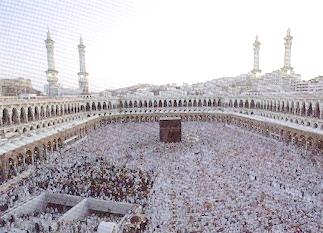
At the mosque I took an escalator up to the
roof and took my time looking at the Kaba from above and feeling the
emotions of the whole atmosphere. The unmistakable "hum" that one hears
that is created by the pilgrims individually reciting their Duas, Dhikr
and Quranic verses as they made their Tawaf around the Holy Kaba.
The
mosques has three levels in addition to the mataf and countless doors,
elevators and escalators. It is the most magnificent structure that I have
ever seen. There are several hundred if not thousands, of speakers, fans,
and chandeliers throughout the mosque, and also several areas with coolers
of Zamzam water. Once during Sai, I enjoyed a good drink from coolers
along the way to Marwah on the second level.
It is quite difficult to
cover the entire 88 acres of the mosque, but I managed to cover most of
the roof and the second floor.
Pilgrims are in constant Tawaf and Sai
at the mosque. I made Tawaf at various times in the day, night and morning
hours, and found that the best time for me was just after Dhur salaat. The
crowd starts again just before Asr.
All three levels of the
mosque and the mataf can be used to perform Tawaf. For the elderly,
relatives or paid-hands sometimes wheel them around, in wheelchairs, on
the mataf, or most times they would choose inside the mosque.During the
evening hours pilgrims also perform Tawaf on the roof, it's is a much
larger area to cover, but at least it is less crowded. On the mataf area
some pilgrims are also carried around the Kaba in a bed made of braided
rope tied around wooden legs ("kathya"), for a fee.
|
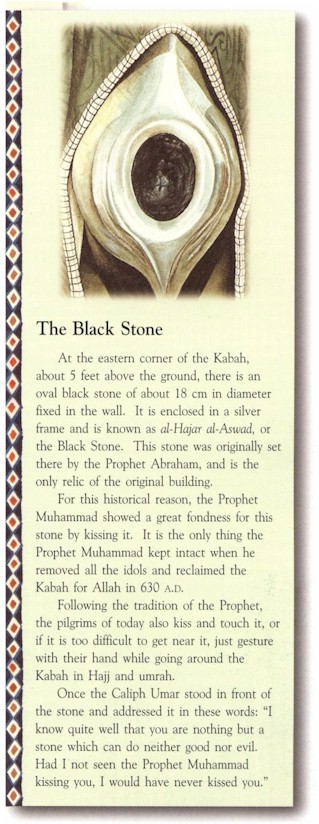 |
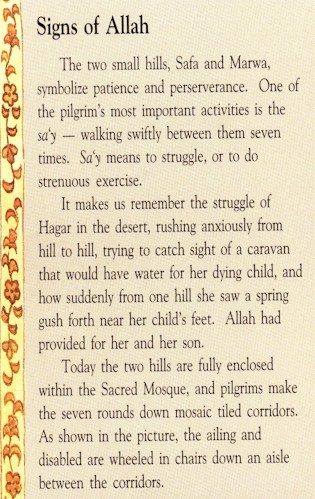 |
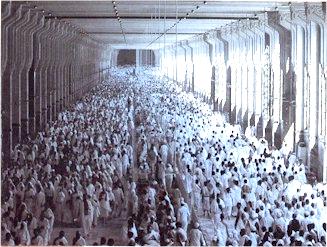
For Sai,
the main floor is divided in two lanes, with the divider acting as a
passageway for wheelchairs. Here again, for a fee, you can be pushed
around in a wheelchair for the seven laps.
On Saturday, our group was taken on Ziara. We visited the
site of the cave of Hira
on Jabal Noor, (a six hour climb for the adventurous), the cave on Jabal
al-Thawr where the Prophet (PBUH) took shelter during his migration,
Mina, Muzdalifah and finally Arafat, and the site of Jabal ar-Rahma.
|
Back at the hotel, I paid at the Office for my Qurbani which was
arranged through the Bank. In earlier years, Qurbani meat used to be dumped and
buried, but Alhamdu-lilla, now the International Development Bank has taken on
the great task of packaging and distributing the meat.
There are two types of
Qurbani distribution to choose from. One that cost a little less will get the
meat distributed to the local people, whilst the other will get distributed
internationally to people in the much needed countries. (top)
Hajj (8th
Zul-Hijjah - 13th Zul Hijjah)
Mina
On Tuesday, March14th, 2000, Zul-Hijjah 8th, 1420 we assumed
Ihram again. We left our baggage in the hotel room but packed a small bag with
snacks, sleeping bag and toiletries to take to Mina. The ride took about two
hours.
All the tents at Mina look alike. They are cream or natural in
color and arranged in sections.
Each section of tents are assigned to specific countries and
others to continents and sub-continents. I saw tents identified for the Arab
speaking countries and for the non-Arab speaking countries. Ours were located in
sub-section 75B of section 19 and we were provided with additional
I.D. cards to wear.
Our group leader had many years of experience and had
arranged for us to be grouped with the South Asia brothers and sisters instead
of the North American group. His decision was based on the fact that he knew the
mutawwif who deals with the South Asia group, who will help him with
arrangements for the busses. The food in this area was more familiar, and also
the tents were much closer than the North American tents, to the Jamarat. Except
for the days that I did Raml Jamarat, I did not venture too much outside of my
tent.
 |
The tents were connected in a row. We occupied two tents because
the sisters were separate from the brothers. We prayed all our salaat in those
tents. It was funny hearing so many Azans being given at one time, because each
group prayed separately they would give their own Azan, via megaphones, while we
were giving our Azan we could hear other groups giving theirs, sometimes even
when we were praying our salaat we could hear the Azan.
Our tents were quite
"luxurious", along with the rug that was used to cover the dusty earth floor,
our group leader had arranged for a 4" foam mattress to be put on top. Although
there was not enough room to accommodate one mattress for each of us, some of
the brothers shared their beds with the less fortunate ones. The air
conditioning in the tent was quite good, during the night some brothers
complained about the cold and it had to be shut off.
The bathrooms here
were "all purpose". The floor was concrete and in the middle was a pear shaped
hole, not unlike the size and shape of a conventional toilet bowl, with marks
for your feet on either side of the "hole". There were no seats, no hooks in the
stalls and no toilet paper. About two feet from the concrete floor was a water
pipe with a 4 to 5 feet section of garden hose attachment, the end of the hose
was always laying on the floor. After you use the toilet, you would then take
the hose, turn the water on and wash yourself and around the toilet area, trying
to get everything into and down the hole. During the Ziara I saw one of these
"toilets" on the side of the road, ready to be installed. Attached to the base
is a tubular metal shaft that's about 20 to 30 feet long and about a foot in
diameter.(top)
Arafat & Muzdalifah
After Fajr on Wednesday, 9th Zul-Hijjah we took a 2 hr. bus trip
to Arafat.
Here we stayed in another type of tent, although all the sides were enclosed,
the ground was bare. Again the sisters stayed in their own ten. As soon as we
settled in, we prayed salatul Zohr and salatul Asr combined and shortened, one
Azan, two Iqamah.
We ate fruits and other dry food then rested for a while
until about 2:00pm. Outside of our tent some brothers were sharing out free cups
of "TANG", a citrus juice, that they had mixed in a huge vat of some sort. Our
group leader and other members of the group, including a Moulana gave lectures
in the tent on the importance of Youmul Arafat and concluded with lengthy duas.
We continued our Wuquf until sunset. I saw some brothers leaving our tent to go
to Jabal
ar-Rahma to do their wuquf.
After sunset, the sides of the tents were
removed by some Saudi workers, but we stayed inside and rested until we had news
of our busses. It was dark. It wasn't until after 11:30pm that the first bus
arrived and by the time we all left it was close to 1:00am.
We arrived at Muzdalifah close to 2:30am in the morning. Because
the busses left separately the group was split up. However, there were capable
group leaders on each of the busses. There were not enought busses for us so the
group leader with us had to charter a private bus to take us.
At Muzdalifah
we prayed salatul Magrib and salatul Isha combined, then collected our pebbles.
There were no tents here but there were lights, it looked like a huge football
field at night. We rolled out our sleeping bags and our prayer mats and slept in
the open air in an empty bus parking lot until it was time for Fajr. Our group
leader commented on the improvements at Muzdalifah from the year before. There
were phone booths, tea vendors and a lot more wudu and bathroom facilities. I
accompanied a brother to call home to his wife in Canada.
After Fajr, we
tried to get transportation for the elderly people in our group to go back to
Mina, but decided it was easier to walk.. They were brave souls and
Alhamdu-lilla after and hour and a half of walking we reached our tents. We
rested for a while then formed small groups to go and perform Raml
Jamarat. (top)
Jamarat
I offered to do the stoning for a sister,
then a few of us followed a brother to the site of the Jamarat. Today we
will only stone the large Jamarat, jamarat
Of Aqabah. The brother (Ahmad)
leading us here was an 18 year old Guyanese now of Canadian nationality,
but living in Makkah. He held up a red umbrella in the air and the group
of about 20 of us followed him through the crowd.
The same road
that is used to go to the jamarat was also used to return to your tents.
Sometimes we battled head-on with the crowd which made it twice as
difficult to proceed. |
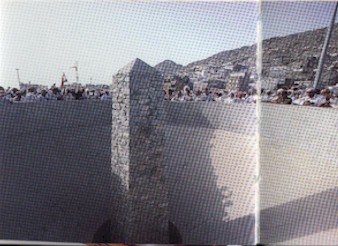 |
In addition, there were people camped out on one side of the
road and vendors on the other side of the road which further reduced the walking
area. Finally about 45 minutes later we arrived at the jamarats. We passed the
first two and did our stoning of the third, the big jamarat. There were signs
identifying them by number and name, the biggest was number 3.
We
re-assembled at a pre arranged spot, then walked past the jamarat to the barbers
located at the end of the walkway. Ahmad recommended the Government barbers
because they used a new razor on everyone head.
Fifteen Saudi Riyals
and about fifteen minutes later we all had clean shaven heads. We gathered
together again and discussed our return trip to the tents. One of my roommates
and I wanted to go to the Haram Shareef to do our Tawaf-ul-Ifada but some
wanted to go back to the tents so we decided to part company.
Ahmad,
our guide also wanted to return to the hotel so my roommate and I accompanied
him. We bought a 10SR ticket and boarded a public bus located further away from
the Jamarat and about 15mins later we got to the Haram. The traffic was
rough.
We went to the hotel, showered, changed into street clothes, ate, then
headed over to the Haram to do our Tawaf and Sai.
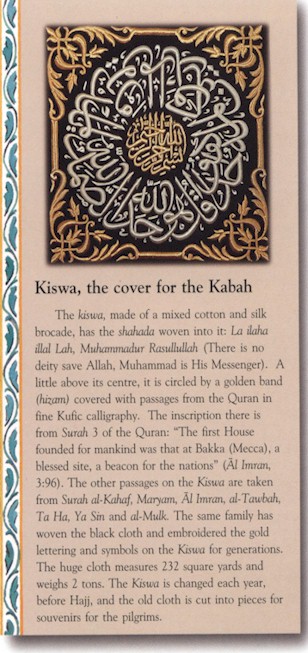 |
Needless to say the Haram was very crowded,
and we got split up. I did my Tawaf on the mataf area but chose to do my
Sai on the second level. I rode an elevator from the main floor up the
second floor and as I was about to start the Azan sounder for Asr Salaat.
I waited to pray then continued with my Sai.
After Isha salat we returned by Taxi to Mina, it wasn't
easy to find our tent. The next day after Dhur, three of us decided to go
to do Raml Jamarat together, we stoned all three jamarats. Even before we
arrived at the Jamarat I got separated from the group but Alhamdu-lilla I
was able to find my way back to the tent.
The next morning after
Fajr, the sisters left to go back to the hotel. We packed out bags and
assigned them to a sister then waited until after Dhur to do Raml Jamarat,
again we stoned all three jamarats. I ended up alone at the Jamarat as
usual and again used the public buses to return to Makkah and my
hotel.
I decided to do an additional Umrah early the following
morning and one of my roommate asked me to take another brother who needed
company and assistance. We left about 2:30am and took a Taxi to Masjid
Eisha, one of the Meeqaats, then returned with the same cab to the
Haram. I started my Tawaf about 3:45am and finished the Sai until after
salatul Fajr, the crowd was huge, I guess some were trying to perform
their Tawaf ul-ifada while others were doing their Tawaf-ul-Wada or
Farewell. |
Back at the hotel one of my roommates shaved my head.
During
the day we (roommates and I) were invited out by Azam, another Guyanese brother
living in Makkah. He took us to his home, fed us some wonderful dates, Al-Baik
chicken and camel meat. We prayed at a nearby mosque then took a taxi back to
the hotel. That night I did not go for Tahajud at the mosque but went for Fajr
salaat with my "roomies", afterwards we ate breakfast at Burger King across from
the Haram.
After salatul Asr, I did my Tawaf-ul-Wada, prayed Magrib and
Isha salaat, took one last long look around the Haram Shareef and the magestic
Kaba then went back to my hotel. We were scheduled to leave for Medina by
9:00pm.that night.
(top)
Medina
As usual, the busses were late and did not
leave until 11:30pm. we stopped at a small mosque to pray Fajr salaat then
continued on. We arrived at about 11:00 am.
As we entered the
outskirts of the city I reflected on the Hijrah and we were helped by our
group leader who reminded us about the people of Medina welcoming
Rasool-Allah with those all so familiar words of "Tala Badru", the Light
has arrived in the city of Medina. |
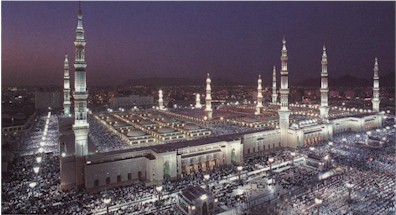 |
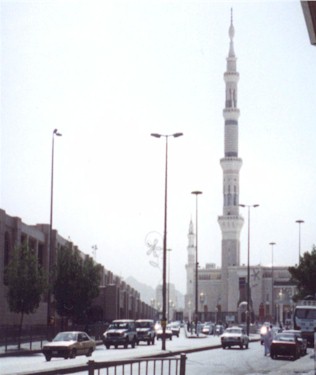 |
After we checked in at the hotel, I prayed
Zohr salaat in my room then went to the Haram with one of my roommates
from the hotel in Makkah.
The mosque was about a 10 minutes walk from
the hotel. The walls of Janatul Baqi was to our left and we passed by lots
of stores, including a string of Jewelry stores to our right.
I
was not prepared for the awesome sight of the Prophet's (PBUH) mosque. It
is magnificent!. None of the pictures that I had seen had ever done
justice to it's beauty and architecture. We entered the mosque with two
things in mind, to pray in the Rowda and to give our salaam to
Rasool-Allah, Abu Bakr Sidique and Umar ibn Khatab. The mosque floor was
covered with thick "area rug type" carpet, quite unlike the Haram in
Makkah Shareef which had no carpet, (I was told that during Umrah, there
are rugs at Makkah Shareef) and the Rowda area is identified by the same
rugs but with a white background instead of dark
red. |
With very little effort, Alhamdu-lilla we found the Rowda and
took turns praying our two rakaat Tahatul Masjid, after that we proceeding to
the grave of Rasool-Allah.
We exited the Rowda and turned left to follow the
crowd. About ten feet from the Rowda to our left we saw a wall of metal grate
lattice. The wall was made up of a series of six doors, two doors side by side,
a separator, the middle set of doors with a separator between them, then another
two doors side by side, at the end. The door that had the most interest was the
first door in the middle set. Each door had a "hole",about 4 to 6 inches in
diameter that was about 5 to 6 feet from the bottom, but this door had a smaller
hole with a large rim around it. This door was identified by one the guards
there as the door to the grave of RasoolAllah (PBUH).
There was about eight
feet between us and this lattice wall and there was also what appears to be a
short wall about 3 feet high right in front of us. Security Guards were standing
on this short wall trying to get the crowd to move along and trying to prevent
the people from making Dua to the graves. We were ushered past the grave site
with just enough time to give our salams, then we turned around, facing the
Qibla (and backing the graves) and made our Dua. After our Dua we exited the
mosque through the gate nearby and returned to the hotel.
Dinner was buffet
style with quite an assortment of dishes to choose from. I was planning to go
back to the mosque in the night but found out at dinner that the mosque closes
at 10:00 pm and reopens at about 3:00am. so I retired to my room and set my
alarm for 2:00am.
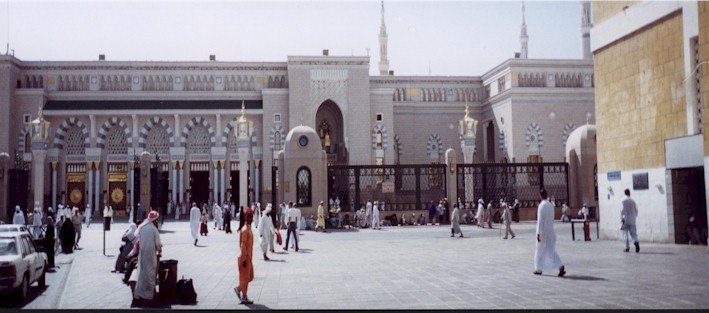 |
I took along a few brothers with me from the Guyana contingent
to show them the Rowda area and got to the mosque at about 2:30am. We waited in
a carpeted area outside the mosque until it was opened at about 3:15am. We
prayed our two rakat in the Rowda and gave salaam to Rasool-Allah then prayed
Tahajud and waited for salatul Fajr.
My other two days at Medina was spent in almost the same way,
one day after salatul Asr I visited Janatul Baqi. As was expected, there are no
markings in the cemetry to identify where the companions of the Prophet are
buried, but there are sections that are boxed around that some group leaders
were identifying as burial sites of some of the sahabahs.
On the second day
that we were there we were taken on Ziara. We visited mount Uhud and the site of
one of the battles where 70 of the companions of the Prophet including his
Uncle, Hamza died. We stopped and prayed in Masjid
Quba and Masjid Qiblatine. Masjid Jummah was closed, it is only opened for
special occasions these days. Outside of Masjid Quba, young Saudi boys were
taking Polaroid pictures for 10SR each.(top)
Returning Home
On Friday March 24th, we prepared to leave Medina for our return
to New York. As usual the bus arrangements were very difficult and at one time
there were concerns that we may not be able to pray salatul Jummah at the mosque
before we left.
After salatul Fajr that morning, and after I had said my
farewell salaam to Rasool-Allah, I was re-directed out of a different
door. As I exited the mosque I looked up to see that I came through the gate of
Jibraeel, the hair on my arm raised as I recalled the significance of that gate,
it was a wonderful feeling.
The busses were late as usual but Alhamu-lilla we were able to
pray salatul Jummah not in the mosque, but in the courtyard, so that we could
have returned quickly to the busses.
We departed Medina at 3:00pm for our 6
hrs. bus ride to Jeddah. We prayed Salatul Asr in the bus while sitting but
stopped along the way at a small mosque to pray Magrib and Isha salaat, finally,
Alhamdu-lilla by about 10:00pm, 7hrs after we left Medina we arrived at the Hajj
Terminal in Jeddah.
It wasn't until 7:45am the following morning that we
boarded our flight to Amman. At Jordan we found out that our flight to New York
will be delayed at least 3 hours. We had time to play around with currency and
found out that the Saudi Riyals was lower than the Jordanian Dinar. It was quite
confusing, at one point we literally opened our palms and had the vendor take
the coin that they needed.
Our 2:15pm flight to New York did not leave until 3:10 and after
an hour wait in Amsterdam, Alhamdu-lilla, we started the last leg of our
journey. During the flight I had time to look at a movie, "Galaxy Quest",
starring Tim Allen, and had the opportunity to meet a Pakistani
brother who shared a lot of my religious experiences as a non-Arabs. It was
the first time that I heard the term "Intellectual Islam". I agreed with the
brother's terminology.
At about 9:30pm Saturday March 25th, we arrived at New York's
J.F.K. Airport. My emotions were running high at the thoughts of my family and
my Mom waiting to greet me, I prayed that Allah will help me to keep my
composure and that he will make me strong.
As if all the delays weren't
enough, the baggage conveyer broke down and we had to wait over an hour for it
to be repaired, during that time we took the opportunity to exchange phone
numbers and email addresses and to embrace each other, wishing each other "Hajj
Mabroor" and safe passage to their homes.
It was a sad parting, Allah (SWT)
had brought us together for a common goal, we had come to know each other within
the last 17 days, some of us shared rooms together, we had endured the
"hardships" together and now you will part and go our separate ways, each taking
his own lessons of Hajj with him, determined to make a change in their lives,
and to pursue the things that will earn Allah's pleasure, not his wrath.(top)
Conclusion
All praises and worship are for Allah (SWT), he created us to
serve him alone and he has made Hajj compulsory for those who could afford it.
Only by his assistance were we able to complete our pilgrimage.
He had
invited only three million of his servants to his house this year and
Alhamdu-lilla he has returned most of us safely to our families.
Our lives
have been enriched by the experiences of Hajj and the bonds of brotherhood
strengthened by the hours and days we spent together in the complete submission
to the will of Allah.
During the lectures we received at Hajj, we were reminded
constantly that when we return home, we should be examples to others, that we
should be identified by our actions and deeds as one who has performed the Holy
pilgrimage.
A fulfilled pilgrim returns to his home, WANTING to do the things
that will please Allah (SWT) trying to prioritize his or her life in the right
order, with Allah (SWT) at the top of that order.
 |
Hajj is one of the best medicines I found for
sickness of the heart. Allah rekindles even a tiny spark of Imaan in your
heart and gives you the unique opportunity to live the life of a
pilgrim.
The atmosphere that surrounds you is filled with unavoidable
remembrances of your Lord. Night and day the praises of Allah (SWT) flows
from your heart to the tip of your tongue. With every passing day at
Makkah your heart begins to soften, Allah (SWT) increases your compassion
manifold even to the extent that you are careful not to harm the leaves on
the small trees on the sidewalk of Makkah.
Personally I will encourage brothers and sisters to make
the Hajj in their early to mid-years, as we all know Allah (SWT) chose to
send the first revelation to RasoolAllah at age forty. By this time the
Prophet (PBUH) was already married and had children, and we all know that
Allah (SWT) is infallible.
If we were to stop and think that
maybe our living in North America is no co-incidence but an orchestrated
plan by Allah (SWT) to bring us to this land, that some think of as the
Shaitaan.
Most of us will have to admit that being in this
part of the world has helped us tremendously to gain knowledge of our
religion, or as the brother put it, "Intellectual Islam".
Allah
has made it possible for us to come this far and has bestowed his mercy
and sustenance on us and he loves those who spend out their hard earnings
to earn his pleasure. |
May Allah forgive me for any mistakes that I may have made in
this article and may he increase my knowledge of religion, InshaAllah.
Ameen.
The purpose of this article is only to share my experiences with
you, it is not meant as a manual for Hajj. Numerous books that will guide you
through the rituals of Hajj and Umrah are available from your local Islamic
Bookstores.


(top)
Some pictures and side bars taken from the children's book, "Tell me
about Hajj" (ISBN #81-87570-00-8).
Jazak Allah to my wife for the tremendous
work she did with the editing of this and all my other publications on the web.
May Allah (SWT) shower his choicest blessings on her. Ameen.
















